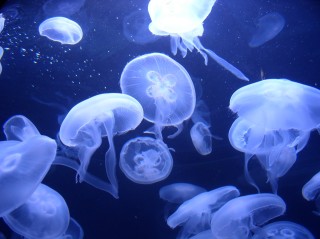We are all aware of the harmful consequences of global warming. We are all taught in school how global warming has increased the average temperature of the earth and thus plays an instrumental role in the melting of ice-caps, leading to the fresh water to flow into the sea and thereby raise the sea-levels. This process further depletes the fresh water resources that are available on our planet, and thus global warming is a major contributor to the water crisis. We also know that water is essential for survival and that it also helps in the maintenance of sanitation levels in a particular area. But what most of us are unaware of, is the relationship between jellyfish and the water crisis.
Yes, you read it write, jellyfish and water crisis. The warm weather and overfishing are the major contributors to the rise in the number of jellyfish in the marine habitats. Overfishing results in the predators being wiped out, which allows the population of the jellyfish to increase. Another possible reason is that algal bloom (which is the increase in the number of algae) has resulted in a decrease in the population of various fish species and has thus set the stage for the increase in the population of jellyfish, which is commonly referred to as jellyfish bloom. The polluted waters witness an increased growth in planktons, upon which the jellyfish feed, and thus the population of jellyfish is also augmented. Most of the members of the animal kingdom cannot survive in polluted waters which are subject to eutrophication, eliminating the competitors of jellyfish and helping the jellyfish score the brownie points in the survival of the fittest.
But how does this jellyfish bloom affect us, you ask? Well, the jellyfish impact our lives in more than one way. Jellyfish stings can be hazardous and even fatal to human health. The increase in the population of jellyfish heightens the risks of these jellyfish stinging the swimmers in the sea and the fishermen during their activities to earn their daily bread. A lion’s mane jellyfish stung 79 people in just one day near Merseyside, England in 2010. Lion’s mane jellyfish have a 7 feet long body, weigh 400 kilograms and have poisonous tentacles which are about 50 feet long.
Jellyfish also impoverish the economic conditions of coastal life. They prey on the eggs of various fish, especially those of their competitors in the food chain. This wipes out the population of competitors and makes it difficult for that species of fish to recover. In 2007, then wiped out a 100,000 fish salmon farm in Ireland. This also led to the fishermen suffering, since there were not enough fish left to catch in order to earn a living. Japan has been badly affected by this decline in the fishing industry, as fishing is a means of survival for most people in the rural sector. Fish also happens to be the main food of the Japanese, as their per capita consumption of fish is the largest in the world and is approximately 128 pounds annually. In order to meet this demand in light of the decrease in supply due to the decline in the fishing industry, Japan has started importing fish.
The jellyfish bloom is a glimpse into the future, a symptom of the pestilence that lies ahead. The population of these jellyfish needs to be controlled, but in order to do that, the first step is to be aware of the current situation and the role that jellyfish play in the environment concerns.
































